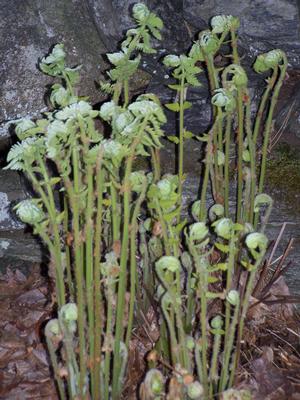Lawns Part III: Lawn Alternatives in Shade
Lawn grasses are sun-lovers growing weakly in shade, the darker the shade: the less likely it is a lawn will establish. If you insist on growing lawn in these areas then you have no choice but remove and/or limb-up trees to allow in enough light.
A dry shady spot might be an opportunity for a hard-scape outdoor room for should that fit your lifestyle needs. Outdoor rooms have been popular design features for several years. You can do-it-yourself with advice and help from home improvement stores or hire a professional to open your eyes to possibilities.
FERNS FORM ELEGANT STANDS IN PART TO FULL SHADE
Hostas, available in many sizes and colors, planted en masse in drier shade will form a weed-proof ground cover in a few short years. Worried about deer and voles? Both creatures ignore elegant ferns (see pic 1). We live in one of the most fern-rich regions on Earth. They are a natural forming elegant stands in part to full shade. Christmas Fern (Polystichum acrostichoides), is virtually evergreen. Early settlers used the fronds for decorations at Christmas, hence the common name. “Maidenhair Fern” (Adiantum pedatum) is a personal favorite displaying delicate pinnate fronds hovering on wiry blackish stems from one 1 to 1.5 feet tall.
Another two possibilities for drier shade to part sun are our native Gernanium (G. maculatum - see pic 2) and False Solomon Seal (Smilacina). Both will flower, ground cover and the Smilacina produces clusters of quite nice berries in mid to late summer at the ends of the handsome arching stems. Mix them all for lovely low-maintenance wild garden.
European Ginger (Asarum europaeum - see pic 3) forms a gorgeous carpet composed of rounded glossy green leaves only a few inches tall content in a rich humus laden soil in full to part shade.
In the difficult dry shade beneath beeches and maples a beautiful answer could be a moss garden with hardy cyclamen (Cyclamen hederifolium, Cyclamen coum) tucked between gnarled surface roots (see pic 4). Moss gardens do require maintenance: weeding and removal of autumn leaves will be imperative. Establishing a moss garden is not difficult. The area will have to first be weeded and cleaned of debris. Choose your moss carefully as species have very specific requirements. Locate ground-growers in shade. If you choose a moss which grows on a rotting log and try to establish it on the ground it will not adapt. In a blender place pieces of moss, plain yogurt, and water in a 1:1:10 part ratio. Liquefy. Dribble or paint the liquid upon moist ground. In a few short weeks you will begin to see infant mosses appear as a green haze. Keep the area moist and soon you will have created an opulent moss garden that will be virtually evergreen. The stronger the mosses grow the fewer weeds with which you will contend. It would be helpful to spray yogurt water (1 part yogurt to 10 parts water) over the area occasionally while they are establishing and maybe once each year after that. It will help to keep your miniature forest happy and green.
Lawn grasses which resent dry shade will rot and perish in perpetually wet conditions. An option in damp to wet shade is Ligularia stenocephala ‘The Rocket’ which will form a beautiful patch. Large showy spikes of yellow flowers to 4 feet or more arise and glow in midsummer shade. Ligularia dentata ‘Othello’ has glossy rounded purple and green leaves on stems to 3 feet tall and will also grow into an impressive groundcover. ‘Britt Marie Crawford’ has the darkest chocolate purple leaves of all of the Ligularia denata cultivars. Rising above the mounds of gorgeous foliage are clusters of golden orange daisy flowers beginning in August and lasting into September.
Attempting to establish lawn where it will not grow naturally is like trying to row a boat over pavement. Either way you won’t make much headway. If you fight Mother Nature you will lose the battle. So, contemplate alternatives. What about groupings of conifers with perhaps some deciduous shrubs mixed-in for seasonal change? Maybe aggressively rooting Mayapple (Podophyllum peltatum) that will squelch weeds, provide seasonal interest in foliage, flowers and produce fruit that can be turned into jelly? How about a garden of ornamental grasses that might relish partial shade and will have to be cut down but once each year? There are numerous possibilities, too many to list here in this format.
I hope I’ve given you some ideas and sparked your creative spirits. Just match the needs of the plants to the area you wish to change, explore what is possible and use your imaginations. You can further your research on-line, in horticultural books and by asking experts. In part IV of the lawn and groundcover series we will consider creative options in wet and sunny environments. Stay tuned.
Penned by Wayne Paquette, Winter 2007


